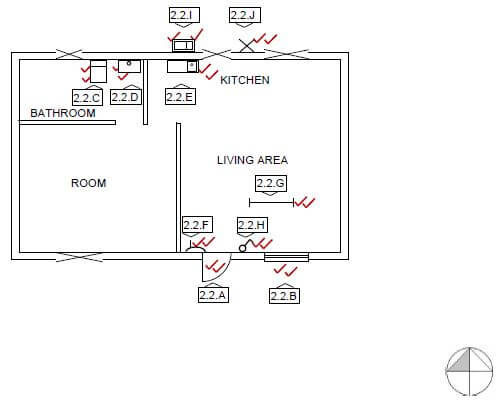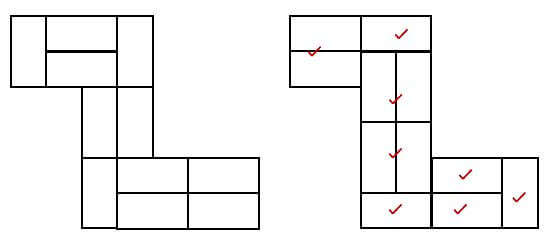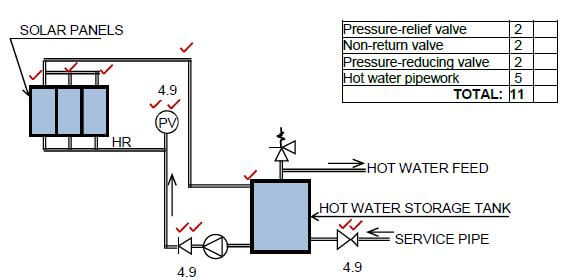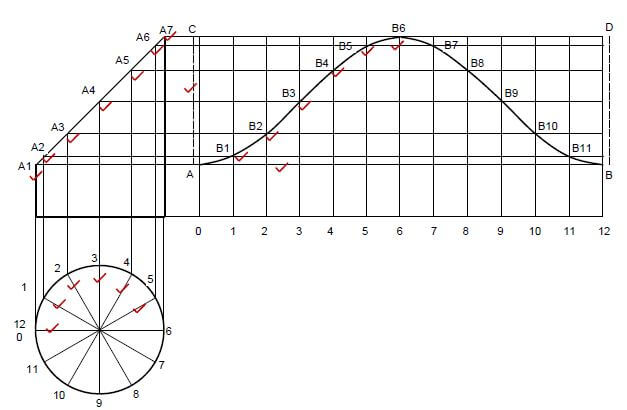Civil Technology Civil Services Grade 12 Memorandum - NSC Exams Past Papers and Memos September 2019 Preparatory Examinations
Share via Whatsapp Join our WhatsApp Group Join our Telegram GroupMEMORANDUM
QUESTION 1: SAFETY, OHSA AND MATERIALS (GENERIC)
1.1 3 m (1)
1.2 (1) By means of a chute or (2) conveyor belt (2)
1.3 Similar answer:
- (1) Prevents unauthorised entry and (2) to protect the public (2)
1.4
1.4.1
- 30°
- 50° (2)
1.4.2
- 760 x 560 mm
3,7 m (2)
1.5
- 1 : 4 = 2 m = 0,5 m (one meter horizontal to four metres vertical) (2)
4
1.6 (1) Not further than 2/3 (2) of the extension length (2)
1.7 (1) The coating of a metal by means of electrolysis (2) with a thin layer of another metal (2)
1.8 Any THREE advantages of electroplating metals:
- Protects against corrosion
- Improves the engineering and mechanical properties of metal
- Increases the thickness of metal
- Resistant against wear and tear (3 x 1) (3)
1.9 Any TWO advantages of galvanising metals:
- Adds strength to the metal
- Increases the thickness of metal
- Prevents staining
- Protects against corrosion (2 x 1) (2) [20]
QUESTION 2: GRAPHICS, JOINING AND EQUIPMENT (GENERIC)
2.1
2.1.1 False (1)
2.1.2 True (1)
2.1.3 True (1)
2.1.4 True (1)
2.1.5 False (1)
2.2 FIGURE 2.2 on ANSWER SHEET A:
2.2.1 Outside door at 2.2.A (2)
2.2.2 Window at 2.2.B (2)
2.2.3 Water closet at 2.2.C (2)
2.2.4 Washbasin at 2.2.D (2)
2.2.5 Single sink unit at 2.2.E (2)
2.2.6 One-way switch single pole at 2.2.F (2)
2.2.7 Fluorescent light at 2.2.G (2)
2.2.8 Socket outlet at 2.2.H (2)
2.2.9 Grease trap at 2.2.I (2)
2.2.10 Wall-mounted light at 2.2.J (2)
2.3
2.3.1 Trim hexagon
2.3.2 Hex flange
2.3.3 Square shoulder screws (3)
2.4
2.4.1 Dumpy level (1)
2.4.2 Any ONE use of this instrument:
- Determine the difference in levels
- Determine levels and slopes
- Setting out buildings
- Transferring levels and heights (1 x 1) (1)
2.4.3
- – Focussing knob
- – Eye piece
- – Foot piece
- – Objective (4 x 1) (4)
2.4.4 (1) To obtain a level / horizontal (2) sight line / reading (2)
2.5 (1) If the moisture inside the level freezes and later reaches normal operating temperature, the moisture can condense (2) inside the tool, where it may damage the circuit board (2)
2.6
- M08 = Thread diameter
- 25 = Thickness (2) [40]
TOTAL SECTION A: 60
QUESTION 3: SAFETY, MATERIAL AND CONSTRUCTION (SPECIFIC)
3.1 Displace dangerous fumes/gases (1)
3.2 Similar answer:
- (1) Worker not fall (2) into opening / in emergency to pull worker out (2)
3.3
3.3.1 Rope grab
3.3.2 Locking snap hook
3.3.3 D-clip (3)
3.4 Zink is a (1) weak atomic bond (2) relative to other metals which during (3) dezincification (when zinc is removed from an alloy) (4) a weak deposit of porous/nobler/copper-rich metal will remain (4)
3.5 Water with an acid content (1)
3.6
3.6.1 Electrode (1)
3.6.2 Boundary (1)
3.6.3 Electrolyte (1)
3.6.4 Passive (1)
3.7 FIGURE 3.7 on ANSWER SHEET B shows layer 1 of a double return angle in a one-brick wall in stretcher bond. Draw the alternate layer of the one-brick wall on scale 1 : 10 on ANSWER SHEET B. (10)
3.8 Any TWO positions where manholes must be placed:
- Before municipal connection
- Every 20–25 m on a straight drain line
- Change of direction
- Change of gradient
- Change of level
- Important junctions (2 x 1) (2)
3.9
3.9.1 False (1)
3.9.2 True (1)
3.9.3 True (1) [30]
QUESTION 4: COLD-WATER SUPPLY, HOT-WATER SUPPLY AND EQUIPMENT (SPECIFIC)
4.1 (1) A fan turns a series of gears (2) that turn the meter dial and register the amount of water used (2)
4.2
4.2.1 Stopcock (1)
4.2.2
- – Spindle
- – Gland nut
- – Jumper
- – Compression fitting
- – Washer (5)
4.2.3 G (1)
4.2.4 Any TWO positions where this type of tap can be installed.
- Water service point
- Water supply pipes to water closet cisterns
- Regulating taps at showers (2 x 1) (2)
4.3 Water-saving attachment (1)
4.4 Cut off water supply (1)
4.5 (1) Polluted water / sand particles (2) affects mechanisms of valves and taps (2)
4.6 (1) When water heats up, (2) it rises (2)
4.7
4.7.1 D (1)
4.7.2 E (1)
4.7.3 G (1)
4.7.4 B (1)
4.7.5 C (1)
4.8
4.8.1 (1) At least 1 m away (2) from the geyser (2)
4.8.2 (1) Must be supported by roof trusses (2) and have at least two legs (2)
4.9 Direct solar hot-water system on ANSWER SHEET B
4.9.1 Draw the pressure-relief valve, non-return valve and pressure-reducing valve symbols in the correct openings marked 4.9, in the pipe system. (6)
4.9.2 Draw the hot-water pipe system from the solar panels to the storage tank. (5)
4.10 Any THREE caring measures which are applicable to the pipe-thread cutting machine.
- Maintain tools
- Keep cutting tools sharp and clean
- Check for misalignment of moving parts
- Use only accessories that are recommended by the manufacturer (3 x 1) (3) [40]
QUESTION 5: DRAINAGE, SANITARY FITMENTS AND QUANTITIES (SPECIFIC)
5.1
5.1.1 Soil water. (1) Contains organic contaminants/human excretions (2) from water closet/urinals (2)
5.1.2 Waste water. (1) Water discharged from (2) sink / washbasin / hand basin / shower / bath (2)
5.2 Any similar answer:
- (1) The water be able to convey solids (2) for adequate flushing of the system/ the system not be blocked (2)
5.3
5.3.1 Socket-and-spigot joint (1)
5.3.2 Ring seal (1)
5.2.3 Keeps out aggressive groundwater/sandy soil and tree roots (1)
5.4 Fully describe the cause of a siphonic action in a drain system.
- (1) When waste water is suddenly (2) discharged from sanitary fixtures on (3) the upper floor, (4) it moves rapidly through the soil pipes. (5) It may suck some air from the lateral branch pipe, (6) resulting in the flow of the water from the trap. (6)
5.5
5.1.1 True (1)
5.1.2 True (1)
5.1.3 False (1)
5.1.4 True (1)
5.6 (1) Remove visible blockages. (2) Fill the sink with 3–4 cm of water. (3) Place the plunger over the opening and push down hard. (3)
5.7 Any TWO properties:
- Durable / strong
- Pleasant, glazed surface
- Different colours (2 x 1) (2)
5.8
5.8.1
- – Inspection eye
- – Soil-water pipe
- – Pipe bend
- – Gully
- – Trap (5)
5.8.2 Cleaning / Removing blockages (1)
5.8.3 40 / 50 mm (1)
5.9
5.9.1 2 (1)
5.9.2 1,3 m + 1,3 m = 2,6 m (2 600 mm) (2)
5.9.3 12 m (12 000 mm) (1)
5.9.4 2 (1)
5.10
5.10.1
- The volume of the tank in m³.
πr²h = 22 x 0,9 x 0,9 x 2,8 = 7,128 m³ (3)
7
5.10.2 The volume of water that the tank can hold. (1)
- 7,13 m³ x 1 000 = 7 128 ℓ [40]
QUESTION 6: GRAPHICS AS A MEANS OF COMMUNICATION, ROOFWORK, STORM WATER AND JOINING (SPECIFIC)
6.1 FIGURE 6.1 on ANSWER SHEET C shows the top and front elevations of a cylindrical pipe with a 45° cut-off.
Draw the development of the pipe on ANSWER SHEET C.
Show all construction lines. (21)
6.2 1 m (1)
6.3 (1) Water proofing of roofs (2) at junctions / where walls protrude above the roof (2)
6.4 Channel water away from the house (1)
6.5
6.5.1 True (1)
6.5.2 False (1)
6.5.3 True (1)
6.6 Any TWO:
- Manufactured from pine-tree bark
- Looks like gum
- Not water soluble
- Dissolves in spirits
- Low melting point
- Inflammable when heated to boiling point
- Soldering brass, copper, tin and lead (2 x 1) (2) [30]
TOTAL: 200
ANSWER SHEET A | CIVIL TECHNOLOGY GENERIC | NAME: |
2.2 Use the information on ANSWER SHEET A and complete the floor plan to scale 1 : 100. 
Outside door at 2.2.A | 2 | |
Window at 2.2.B | 2 | |
Water closet at 2.2.C | 2 | |
Wash basin at 2.2.D | 2 | |
Single sink unit at 2.2.E | 2 | |
One-way switch-single pole at 2.2.F | 2 | |
Fluorescent light at 2.2.G | 2 | |
Socket outlet at 2.2.H | 2 | |
Grease trap at 2.2.I | 2 | |
Wall-mounted light at 2.2.J TOTAL: 20 | 2 | |
ANSWER SHEET B | CIVIL TECHNOLOGY CIVIL SERVICES | NAME: |
3.7 FIGURE 3.7 on ANSWER SHEET B shows layer 1 of a double return angle in a one-brick wall in stretcher bond. Draw the alternate layer of the one brick wall on scale 1 : 10 on ANSWER SHEET B. (10) 
Brickwork | 8 | |
Application of scale | 2 | |
TOTAL: 10 |
4.9 Complete the diagrammic representation of a pumped direct solar hot-water system on ANSWER SHEET B by drawing in the following parts: 
ANSWER SHEET C | CIVIL TECHNOLOGY CIVIL SERVICES | NAME: |
6.1 FIGURE 6.1 on ANSWER SHEET C shows the top and front elevations of a cylindrical pipe with a 45° cut-off.
Draw the development of the pipe on ANSWER SHEET C.
Show all construction lines. (21) . 
Base line A-B | 1 | |
Seam lines A-C and B-D | 1 | |
Dividing lines 0-12 on top view | 6 | |
Vertical and horizontal construction lines A1–A7 | 7 | |
Intersection points and development lines B1–B11 6 | ||
TOTAL: 21 |